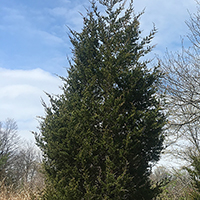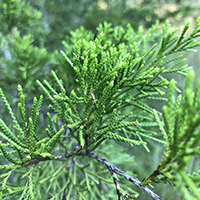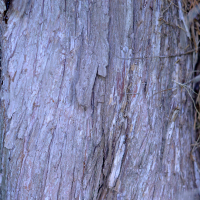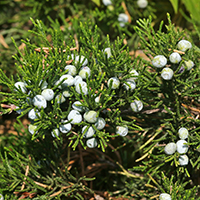What eastern redcedar looks like
Size and shape
- Reaches 10 metres tall.
- Slow growing.
- Looks like a cedar tree but is a tree-sized juniper.
Needles
- Sharply pointed needles and softer, rounded scale leaves.
- Bluish-green in colour.
Bark
- Thin, grey bark.
- Old bark peels off in long, fibrous strands.
Fruit
- Cones that look like berries.
- Have a bluish-white powder on the surface.
Where eastern redcedar is found
Eastern redcedar is found in Eastern Ontario and scattered along the shores of Lake Huron, Lake Erie and Georgian Bay as far north as the French River. It is often abundant on roadsides and in abandoned fields.
What you need to know to grow eastern redcedar
- Moisture: grows best on dry to average moisture sites.
- Soil: grows best in well drained loamy, sandy or rocky alkaline soils but also tolerates acidic soils.
- Shade: intolerant of shade.
Benefits and uses of eastern redcedar
Wildlife benefits
Eastern redcedar provides shelter and a food source for birds and mammals such as deer. Several bird and small mammal species, such as cedar waxwings, turkeys, foxes and skunks eat eastern redcedar cones.
Commercial uses
Eastern redcedar is useful for windbreaks and hedges on tough, dry, limestone-based soils where little else grows. It rarely requires pruning but tolerates clipping so is sometimes used in ornamental gardens.
Eastern redcedar wood is valued for its resistance to insects and rot. It is used for lining chests and closets, fence posts, outdoor furniture and lumber.
Fun facts about eastern redcedar
- Migratory seed-eating birds are thought to be responsible for the scattered pockets of eastern redcedar near many lakes.



